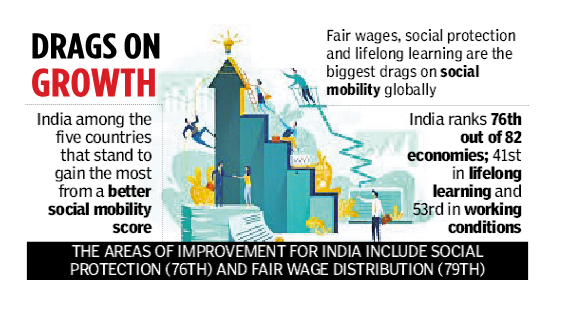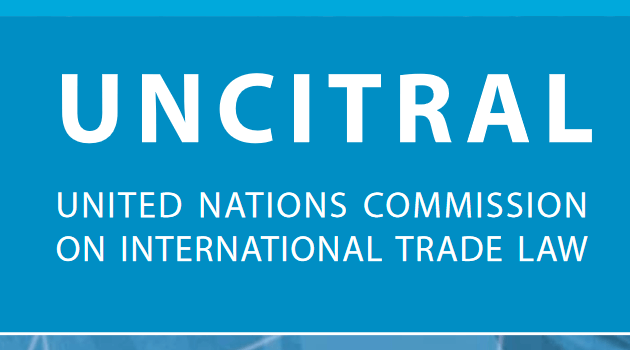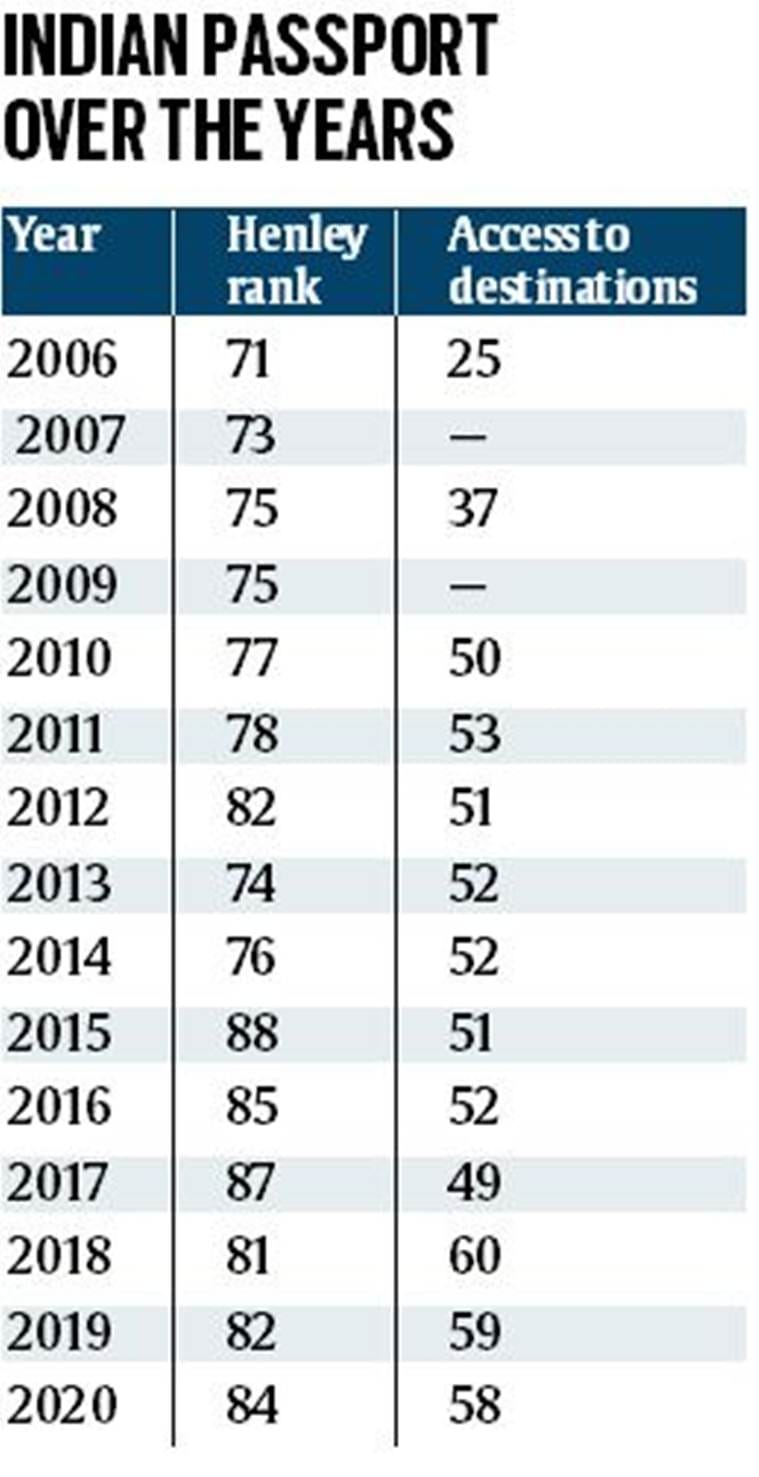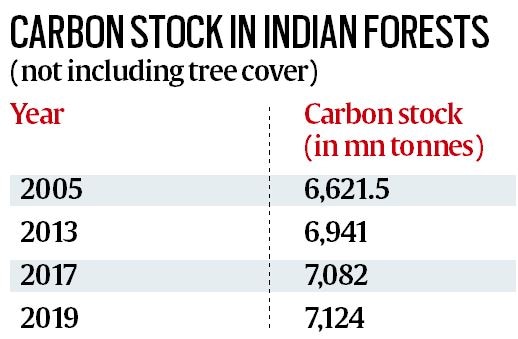Note4Students
From UPSC perspective, the following things are important :
Prelims level: Global Social Mobility Report 2020 and its highlights
Mains level: Social Mobility

The Global Social Mobility Report was recently released at the ongoing World Economic Forum at Davos, Switzerland.
Global Social Mobility Report
- The World Economic Forum organizes the well-known annual gathering of the world’s most influential business and political decision-makers at Davos.
- It has come out with its first-ever Global Social Mobility Report, which has ranked India a lowly 72 out of the 82 countries profiled.
- According to the report, the Nordic economies such as Denmark and Finland top the social mobility rankings while countries like India, Pakistan, Bangladesh and South Africa languish at the bottom (see Table 1).
Table 1: WEF’s Global Social Mobility Rankings
| Country |
Rank (out of 82) |
| Denmark |
1 |
| Germany |
11 |
| United Kingdom |
21 |
| United States |
27 |
| Russia |
39 |
| China |
45 |
| Saudi Arabia |
52 |
| Brazil |
60 |
| India |
76 |
| Pakistan |
79 |
What is the context for this report?
- Notwithstanding fast global growth, inequalities have been growing across the world.
- The rise of inequality has not only created massive social unrest but also adversely affected the global consensus on the kind of economic policies that countries follow.
- A good example of this is the rise of trade protectionism across the world over the past few years.
- Be it US or the UK several countries have started looking inwards in the hope that greater trade protectionism will help allay the fears and apprehensions of domestic workers.
What is Social Mobility?
- Typically, inequalities are measured in income terms. And this measure has been found inadequate.
- As the report states, “many situations exist where, despite high levels of absolute income mobility, relative social mobility remains low.
- For example, in economies such as China and India, economic growth can lift entire populations upward in terms of absolute income, but an individual’s status in society relative to others remains the same”.
- The report states: “The notion of relative social mobility is more closely related to the social and economic status of an individual relative to their parents. I
- n a country with a society with perfect relative mobility, a child born in a low-income family would have as much chance to earn a high income as a child born to parents who earn a high income”.
Thus, the concept of social mobility is much broader than just looking at income inequality. It encompasses several concerns such as:
- Intragenerational mobility: The ability for an individual to move between socio-economic classes within their own lifetime.
- Intergenerational mobility: The ability for a family group to move up or down the socio-economic ladder across the span of one or more generations.
- Absolute income mobility: The ability for an individual to earn, in real terms, as much as or more than their parents at the same age.
- Absolute educational mobility: The ability for an individual to attain higher education levels than their parents.
- Relative income mobility: How much of an individual’s income is determined by their parents’ income.
- Relative educational mobility: How much of an individual’s educational attainment is determined by their parents’ educational attainment.
Why does social mobility matter?
- How far an individual can move up in the society determines a lot whether one is closer to the income “floor” (or poor) or “ceiling” (or rich).
- Social mobility levels, then, can help us understand both the speed – that is, how long it takes for individuals at the bottom of the scale to catch up with those at the top – and the intensity – that is, how many steps it takes for an individual to move up the ladder in a given period – of social mobility.
- Research also shows that countries with high levels of relative social mobility—such as Finland, Norway or Denmark— exhibit lower levels of income inequality.
- Conversely, countries with low relative social mobility—such as India, South Africa or Brazil—also exhibit high levels of economic inequality.
- That’s why it matters for countries like India to increase social mobility.
As shown in Table 2, it would take a whopping 7 generations for someone born in a low-income family in India to approach mean income level; in Denmark, it would only take 2 generations.
Table 2: Income Mobility across Generations
| Country |
Number of generations required by a poor family member to achieve mean income level |
| Denmark |
2 |
| United States/ United Kingdom |
5 |
| Germany/ France |
6 |
| India/China |
7 |
| Brazil/South Africa |
9 |
So, how is social mobility calculated?
The WEF’s Global Social Mobility Index assesses the 82 economies on “10 pillars” spread across the following five key dimensions of social mobility:
- Health;
- Education (access, quality and equity, lifelong learning);
- Technology;
- Work (opportunities, wages, conditions);
- Protection and Institutions (social protection and inclusive institutions).
How did India perform on each of the 10 pillars of social mobility?
India’s overall ranking is a poor 76 out of the 82 countries considered. Thus it should not come as any surprise that India ranks lowly in individual parameters as well.
Table 3 below provides the detailed breakup.
Table 3: Where India ranks on the 10 Pillars of Social Mobility
| Parameter |
Rank (out of 82 countries) |
| Health |
73 |
| Access to Education |
66 |
| Quality and Equity in Education |
77 |
| Lifelong learning |
41 |
| Access to Technology |
73 |
| Work Opportunities |
75 |
| Fair Wage Distribution |
79 |
| Working Conditions |
53 |
| Social Protection |
76 |
| Inclusive Institutions |
67 |
Back2Basics
World Economic Forum (WEF)
- The WEF based in Cologny-Geneva, Switzerland, is an NGO founded in 1971.
- The WEF’s mission is cited as “committed to improving the state of the world by engaging business, political, academic, and other leaders of society to shape global, regional, and industry agendas”.
- It is a membership-based organization, and membership is made up of the world’s largest corporations.
- The WEF hosts an annual meeting at the end of January in Davos, a mountain resort in Graubünden, in the eastern Alps region of Switzerland.
Various reports published by WEF:
[Tikdam: Most (Not all) reports titled with ‘Global’ are released by WEF.]
- Global Competitiveness Report
- Global Information Technology Report
- Global Gender Gap Report
- Global Travel and Tourism Report
- Global Enabling Trade Report etc.
Get an IAS/IPS ranker as your 1: 1 personal mentor for UPSC 2024
Attend Now














